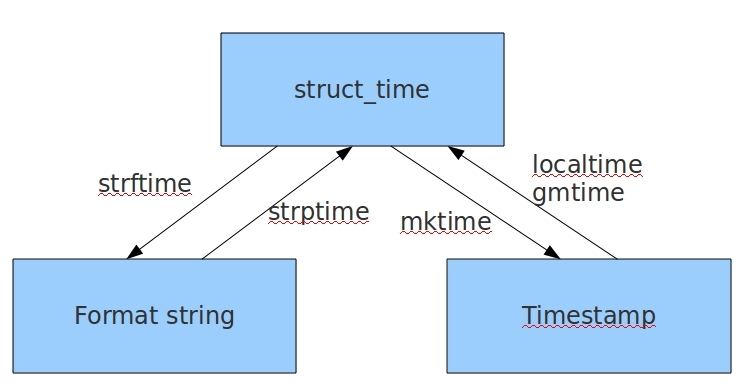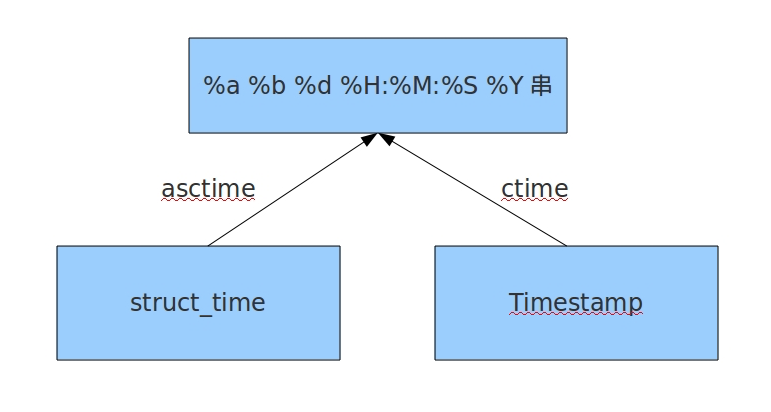一、time模块
表示时间的三种方式:
时间戳:数字(计算机能认识的)
时间字符串:t='2012-12-12'
结构化时间:time.struct_time(tm_year=2017, tm_mon=8, tm_mday=8, tm_hour=8, tm_min=4, tm_sec=32, tm_wday=1, tm_yday=220, tm_isdst=0)像这样的就是结构化时间
import time
2 # 对象:对象.方法
3 # ----------------------------------
4 # 1.时间戳(数字):给计算机的看的
5 print(time.time())#当前时间的时间戳
6 print(time.localtime())#结构化时间对象
7 s=time.localtime() #当前的结构化时间对象(utc时间)
8 print(s.tm_year)
9 s2=time.gmtime() #这个和localtime只是小时不一样
10 print(s2)
11
12
13 #-----------------------------------
14 # 2.时间的转换
15 print(time.localtime(15648461))#把时间戳转换成结构化时间
16 t='2012-12-12' #这是一个字符串时间
17 print(time.mktime(time.localtime()))#将结构化时间转换成时间戳
18 print(time.strftime("%Y-%m-%d",time.localtime()))#将结构化时间转换成字符串时间
19 print(time.strftime('%y/%m/%d %H:%M:%S'))#小写的y是取得年的后两位
20 print(time.strptime('2008-03-12',"%Y-%m-%d"))#将字符串时间转换成结构化时间
%y 两位数的年份表示(00-99) 2 %Y 四位数的年份表示(000-9999) 3 %m 月份(01-12) 4 %d 月内中的一天(0-31) 5 %H 24小时制小时数(0-23) 6 %I 12小时制小时数(01-12) 7 %M 分钟数(00=59) 8 %S 秒(00-59) 9 %a 本地简化星期名称 10 %A 本地完整星期名称 11 %b 本地简化的月份名称 12 %B 本地完整的月份名称 13 %c 本地相应的日期表示和时间表示 14 %j 年内的一天(001-366) 15 %p 本地A.M.或P.M.的等价符 16 %U 一年中的星期数(00-53)星期天为星期的开始 17 %w 星期(0-6),星期天为星期的开始 18 %W 一年中的星期数(00-53)星期一为星期的开始 19 %x 本地相应的日期表示 20 %X 本地相应的时间表示 21 %Z 当前时区的名称 22 %% %号本身 23 24 python中时间日期格式化符号:

time.strftime('格式定义',‘结构化时间’) 结构化时间参数若不传,则显示当前时间
|
1
2
3
|
print(time.strptime('2008-03-12',"%Y-%m-%d"))print(time.strftime('%Y-%m-%d'))print(time.strftime("%Y-%m-%d",time.localtime(15444))) |

print(time.asctime(time.localtime(150000))) 2 print(time.asctime(time.localtime())) 3 # time.ctime(时间戳)如果不传参数,直接返回当前时间的格式化字符串 4 print(time.ctime()) 5 print(time.ctime(150000))
二、random模块
import random 2 # ---------------------------- 3 # 1.随机小数 4 print(random.random()) #大于0且小于1之间的随机小数 5 print(random.uniform(1,3)) #大于1且小于3的随机小数 6 7 # ---------------------------- 8 # 2.随机整数 9 print(random.randint(1,5)) #大于1且小于等于5之间的整数 10 print(random.randrange(1,10,2)) #大于等于1且小于3之间的整数(且是所有的奇数) 11 12 # ---------------------------- 13 # 3.随机选择一个返回 14 print(random.choice([1,'23',[4,5]])) 15 # ---------------------------- 16 # 4.随机选择返回多个 17 print(random.sample([1,'23',[4,5]],2)) #列表元素任意两个组合 18 # ---------------------------- 19 20 21 # ---------------------------- 22 # 5.打乱列表顺序 23 item=[1,5,2,3,4] 24 random.shuffle(item) #打乱次序 25 print(item)
# 验证码小例子(这个只是产生随机的四位数字)
2 # 方法一、
3 # l=[]
4 # for i in range(4):
5 # l.append(str(random.randint(0,9)))
6 # print(''.join(l))
7 # print(l)
8
9
10 # 方法二
11 # print(random.randint(1000,9999))
12
13
14 # 验证码升级版
15 # 要求:首次要有数字,其次要有字母,一共四位,可以重复
16 # chr(65-90)#a-z
17 # chr(97-122)#A-Z
18
19 方法一
20 # num_list = list(range(10))
21 # new_num_l=list(map(str,num_list))#['0','1'...'9']
22 # l=[] #用来存字母
23 # for i in range(65,91):
24 # zifu=chr(i)
25 # l.append(zifu) #['A'-'Z']
26 # new_num_l.extend(l) #要把上面的数字和下面的字母拼在一块
27 # print(new_num_l)
28 # ret_l=[] #存生成的随机数字或字母
29 # for i in range(4): #从new_num_l里面选数字选择四次就放到了ret_l里面)
30 # ret_l.append(random.choice(new_num_l))
31 # # print(ret_l)
32 # print(''.join(ret_l)) #拼成字符串
33
34 方法二
35 # import random
36 # def myrandom():
37 # new_num_l=list(map(str,range(10)))
38 # l=[chr(i) for i in range(65,91)]
39 # new_num_l.extend(l)
40 # ret_l=[random.choice(new_num_l) for i in range(4)]
41 # return ''.join(ret_l)
42 # print(myrandom())
43
44 方法三
45 import random
46 l=list(str(range(10)))+[chr(i) for i in range(65,91)]+[chr(j) for j in range(97,122)]
47 print(''.join(random.sample(l,4)))
三、os模块
os.getcwd() 获取当前工作目录,即当前python脚本工作的目录路径
2 os.chdir("dirname") 改变当前脚本工作目录;相当于shell下cd
3 os.curdir 返回当前目录: ('.')
4 os.pardir 获取当前目录的父目录字符串名:('..')
5 os.makedirs('dirname1/dirname2') 可生成多层递归目录
6 os.removedirs('dirname1') 若目录为空,则删除,并递归到上一级目录,如若也为空,则删除,依此类推
7 os.mkdir('dirname') 生成单级目录;相当于shell中mkdir dirname
8 os.rmdir('dirname') 删除单级空目录,若目录不为空则无法删除,报错;相当于shell中rmdir dirname
9 os.listdir('dirname') 列出指定目录下的所有文件和子目录,包括隐藏文件,并以列表方式打印
10 os.remove() 删除一个文件
11 os.rename("oldname","newname") 重命名文件/目录
12 os.stat('path/filename') 获取文件/目录信息
13 os.sep 输出操作系统特定的路径分隔符,win下为"\",Linux下为"/"
14 os.linesep 输出当前平台使用的行终止符,win下为"
",Linux下为"
"
15 os.pathsep 输出用于分割文件路径的字符串 win下为;,Linux下为:
16 os.name 输出字符串指示当前使用平台。win->'nt'; Linux->'posix'
17 os.system("bash command") 运行shell命令,直接显示
18 os.popen("bash command) 运行shell命令,获取执行结果
19 os.environ 获取系统环境变量
20
21
22 os.path
23 os.path.abspath(path) 返回path规范化的绝对路径 os.path.split(path) 将path分割成目录和文件名二元组返回 os.path.dirname(path) 返回path的目录。其实就是os.path.split(path)的第一个元素 os.path.basename(path) 返回path最后的文件名。如何path以/或结尾,那么就会返回空值。
24 即os.path.split(path)的第二个元素
25 os.path.exists(path) 如果path存在,返回True;如果path不存在,返回False
26 os.path.isabs(path) 如果path是绝对路径,返回True
27 os.path.isfile(path) 如果path是一个存在的文件,返回True。否则返回False
28 os.path.isdir(path) 如果path是一个存在的目录,则返回True。否则返回False
29 os.path.join(path1[, path2[, ...]]) 将多个路径组合后返回,第一个绝对路径之前的参数将被忽略
30 os.path.getatime(path) 返回path所指向的文件或者目录的最后访问时间
31 os.path.getmtime(path) 返回path所指向的文件或者目录的最后修改时间
32 os.path.getsize(path) 返回path的大小
注意:os.stat('pathfilename') 获取文件目录信息的结构说明
|
1
2
3
4
5
6
7
8
9
10
11
12
13
14
|
stat 结构:st_mode: inode 保护模式st_ino: inode 节点号。st_dev: inode 驻留的设备。st_nlink: inode 的链接数。st_uid: 所有者的用户ID。st_gid: 所有者的组ID。st_size: 普通文件以字节为单位的大小;包含等待某些特殊文件的数据。st_atime: 上次访问的时间。st_mtime: 最后一次修改的时间。st_ctime: 由操作系统报告的"ctime"。在某些系统上(如Unix)是最新的元数据更改的时间,<br>在其它系统上(如Windows)是创建时间(详细信息参见平台的文档)。ststat 结构 |
四、sys模块
sys模块是与python解释器交互的一个接口
import sys
2 print(sys.argv) #实现从程序外部向程序传递参数。(在命令行里面输打开路径执行)
3 name=sys.argv[1] #命令行参数List,第一个元素是程序的本身路径
4 password = sys.argv[2]
5 if name=='egon' and password == '123':
6 print('继续执行程序')
7 else:
8 exit()
9
10 sys.exit()#退出程序,正常退出时exit(0)
11 print(sys.version)#获取python解释的版本信息
12 print(sys.maxsize)#最大能表示的数,与系统多少位有关
13 print(sys.path)#返回模块的搜索路径,初始化时使用PYTHONPATH环境变量的值
14 print(sys.platform)#返回操作系统平台名称
五、序列化模块
1.什么是序列化-------将原本的字典,列表等内容转换成一个字符串的过程就叫做序列化
2.序列化的目的
1.以某种存储形式使自定义对象持久化
2.将对象从一个地方传递到另一个地方
3.使程序更具维护性
json
Json模块提供了四个功能:dumps、loads、dump、load
import json
2 dic={'k1':'v1','k2':'v2','k3':'v3'}
3 print(type(dic))
4 str_dic = json.dumps(dic) #将字典转换成字符串,转换后的字典中的元素是由双引号表示的
5 print(str_dic,type(str_dic))#{"k1": "v1", "k2": "v2", "k3": "v3"} <class 'str'>
6
7
8 dic2 = json.loads(str_dic)#将一个字符串转换成字典类型
9 print(dic2,type(dic2))#{'k1': 'v1', 'k2': 'v2', 'k3': 'v3'} <class 'dict'>
10
11 list_dic = [1,['a','b','c'],3,{'k1':'v1','k2':'v2'}]
12 str_dic = json.dumps(list_dic) #也可以处理嵌套的数据类型
13 print(type(str_dic),str_dic) #<class 'str'> [1, ["a", "b", "c"], 3, {"k1": "v1", "k2": "v2"}]
14 list_dic2 = json.loads(str_dic)
15 print(type(list_dic2),list_dic2) #<class 'list'> [1, ['a', 'b', 'c'], 3, {'k1': 'v1', 'k2': 'v2'}]
import json
2 f=open('json_file','w')
3 dic = {'k1':'v1','k2':'v2','k3':'v3'}
4 json.dump(dic,f)# #dump方法接收一个文件句柄,直接将字典转换成json字符串写入文件
5 f.close()
6
7 f = open('json_file')
8 dic2 = json.load(f) #load方法接收一个文件句柄,直接将文件中的json字符串转换成数据结构返回
9 f.close()
10 print(type(dic2),dic2)
pickle
json 和 pickle 模块
json:用于字符串和python数据类型之间进行转换
pickle:用于python特有的类型和python的数据类型进行转换
# --------------------------
2 import pickle
3 # dic= {'k1':'v1','k2':'v2','k3':'v3'}
4 # str_dic=pickle.dumps(dic)
5 # print(str_dic) #打印的是bytes类型的二进制内容
6 #
7 # dic2 = pickle.loads(str_dic)
8 # print(dic2) #有吧字典给转换回来了
9
10 import time
11 struct_time = time.localtime(1000000000)
12 print(struct_time)
13 f = open('pickle_file','wb')
14 pickle.dump(struct_time,f)
15 f.close()
16
17 f = open('pickle_file','rb')
18 struct_time2 = pickle.load(f)
19 print(struct_time.tm_year)
shelve
shelve也是python提供给我们的序列化工具,比pickle用起来更简单一些。
shelve只提供给我们一个open方法,是用key来访问的,使用起来和字典类似。
import shelve
2 f = shelve.open('shelve_file')
3 f['key'] = {'int':10, 'float':9.5, 'string':'Sample data'} #直接对文件句柄操作,就可以存入数据
4 f.close()
5
6 import shelve
7 f1 = shelve.open('shelve_file')
8 existing = f1['key'] #取出数据的时候也只需要直接用key获取即可,但是如果key不存在会报错
9 f1.close()
10 print(existing)
11
12 shelve
这个模块有个限制,它不支持多个应用同一时间往同一个DB进行写操作。所以当我们知道我们的应用如果只进行读操作,我们可以让shelve通过只读方式打开DB
1 import shelve
2 f = shelve.open('shelve_file', flag='r')
3 existing = f['key']
4 f.close()
5 print(existing)
由于shelve在默认情况下是不会记录待持久化对象的任何修改的,所以我们在shelve.open()时候需要修改默认参数,否则对象的修改不会保存。
import shelve
f1 = shelve.open('shelve_file')
print(f1['key'])
f1['key']['new_value'] = 'this was not here before'
f1.close()
f2 = shelve.open('shelve_file', writeback=True)
print(f2['key'])
f2['key']['new_value'] = 'this was not here before'
f2.close()
设置writeback
writeback方式有优点也有缺点。优点是减少了我们出错的概率,并且让对象的持久化对用户更加的透明了;但这种方式并不是所有的情况下都需要,首先,使用writeback以后,shelf在open()的时候会增加额外的内存消耗,并且当DB在close()的时候会将缓存中的每一个对象都写入到DB,这也会带来额外的等待时间。因为shelve没有办法知道缓存中哪些对象修改了,哪些对象没有修改,因此所有的对象都会被写入。
